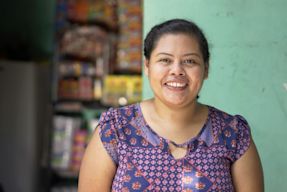
Women are a strong force for good in the world. Countless studies show that when women have equal access to resources, entire communities benefit from the additional productivity. One of the strongest levers to pull to advance international development is the inclusion of women.
Women are at an economic disadvantage. Worldwide, women earn 63% less than men and spend three times as many hours on unpaid labor such as housework. Access to capital, like formal bank loans, is a primary constraint to the growth of female-owned businesses.
Over 1 billion women in the world don’t have equal access to capital. That’s a big opportunity for change.
These women don’t have the resources to open a savings account, access necessary credit, or make financial transactions through formal markets. It’s the reason that more than 80% of our loans go to women: because our lenders recognize the disadvantage women have in achieving financial freedom.
Access to capital could be the guiding factor in deciding to send your child to school or keeping them at home to help the family business. Maybe it’s the difference between working for low pay at a menial job or pursuing your passion for creating clothes. It could be the determining factor in your family’s health and happiness.
How we can all make change
It’s time to recognize the opportunity and the power that we at Kiva and you as a lender have to change the world by ensuring financial inclusion for women in every country.
By crowdfunding microloans, Kiva lenders empower women to pursue their aspirations and gain decision-making power in their homes and communities. Women like Zimbabwean fish-farmer Beauty have witnessed many in their communities in abusive relationships they feel they cannot leave. Financial independence is crucial to changing that power dynamic, which is why concepts like loan access are so important.
Women also face many disadvantages starting businesses compared to their male counterparts. The number of women involved in early-stage entrepreneurial activity is half or less the number of men in 40% of the world’s economies. When our lenders invest in Kiva loans to women, they provide a pipeline of capital for women. As a result, women are able to start new businesses, grow existing businesses, or invest in education for themselves and their families.
When facing difficult situations, like war and displacement, women like Syrian refugee Nour must work extra hard to provide for their families. That’s where microloan opportunities on platforms like Kiva are essential: with a loan of $700, funded by Kiva lenders, Nour purchased clothes to stock here store and grew her profits from $250 per month to $400 per month.
Financial inclusion is where empowerment and inspiration come from. Even with a small loan, women finally hold the power to create their own future. As a lender, you can fuel that experience.
 Jackline of Nairobi used her loan for university tuition at Strathmore, where she's studying commerce.
Jackline of Nairobi used her loan for university tuition at Strathmore, where she's studying commerce.PREVIOUS ARTICLE
Kiva borrowers to thriving business people: The art edition →NEXT ARTICLE
How we got to $1 billion: A look at Kiva’s history →













